ACCC v TPG Internet Pty Ltd Case Analysis - Business Law BUS101
VerifiedAdded on 2023/06/04
|7
|1556
|353
Case Study
AI Summary
This case study provides an in-depth analysis of the Australian Competition and Consumer Commission (ACCC) v TPG Internet Pty Ltd case, focusing on the legal implications of TPG's advertising campaign between 2010 and 2011. The ACCC argued that TPG's advertisements, which prominently featured an unlimited ADSL2+ service for $29.99 per month while obscuring additional bundling costs and setup fees, were deceptive and misleading under s 18 of the ACL and s 52 of the TPA. The case examines the differing opinions of the Primary Judge, the Full Court Judges, and ultimately the High Court's verdict, which reinstated the primary judge's ruling and imposed a $2 million penalty on TPG. The analysis highlights the importance of clear and conspicuous disclosure of all costs associated with advertised services to avoid misleading consumers, providing a detailed overview of the legal arguments and judicial reasoning involved in this significant consumer law case. Desklib provides a platform for students to access similar solved assignments and past papers.
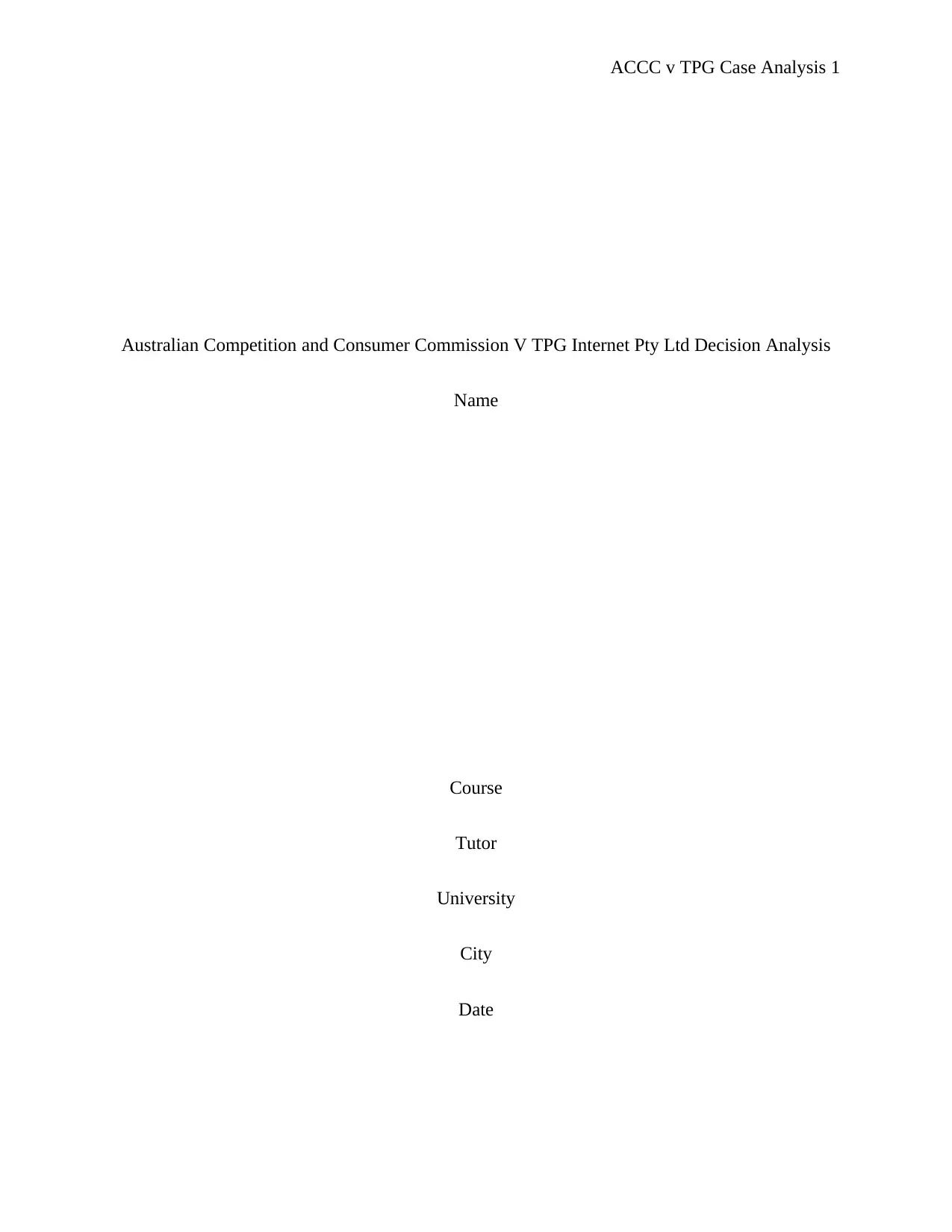
ACCC v TPG Case Analysis 1
Australian Competition and Consumer Commission V TPG Internet Pty Ltd Decision Analysis
Name
Course
Tutor
University
City
Date
Australian Competition and Consumer Commission V TPG Internet Pty Ltd Decision Analysis
Name
Course
Tutor
University
City
Date
Paraphrase This Document
Need a fresh take? Get an instant paraphrase of this document with our AI Paraphraser
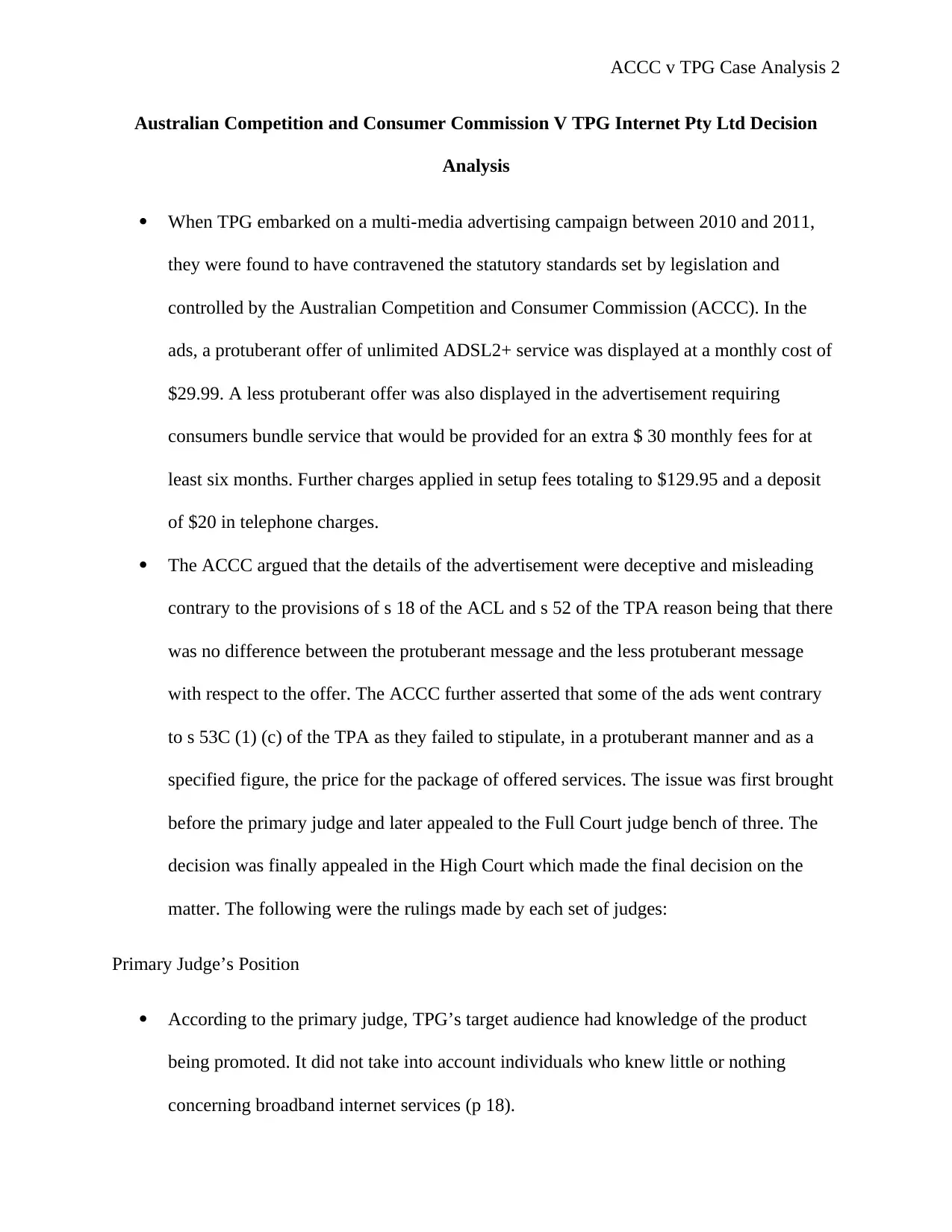
ACCC v TPG Case Analysis 2
Australian Competition and Consumer Commission V TPG Internet Pty Ltd Decision
Analysis
When TPG embarked on a multi-media advertising campaign between 2010 and 2011,
they were found to have contravened the statutory standards set by legislation and
controlled by the Australian Competition and Consumer Commission (ACCC). In the
ads, a protuberant offer of unlimited ADSL2+ service was displayed at a monthly cost of
$29.99. A less protuberant offer was also displayed in the advertisement requiring
consumers bundle service that would be provided for an extra $ 30 monthly fees for at
least six months. Further charges applied in setup fees totaling to $129.95 and a deposit
of $20 in telephone charges.
The ACCC argued that the details of the advertisement were deceptive and misleading
contrary to the provisions of s 18 of the ACL and s 52 of the TPA reason being that there
was no difference between the protuberant message and the less protuberant message
with respect to the offer. The ACCC further asserted that some of the ads went contrary
to s 53C (1) (c) of the TPA as they failed to stipulate, in a protuberant manner and as a
specified figure, the price for the package of offered services. The issue was first brought
before the primary judge and later appealed to the Full Court judge bench of three. The
decision was finally appealed in the High Court which made the final decision on the
matter. The following were the rulings made by each set of judges:
Primary Judge’s Position
According to the primary judge, TPG’s target audience had knowledge of the product
being promoted. It did not take into account individuals who knew little or nothing
concerning broadband internet services (p 18).
Australian Competition and Consumer Commission V TPG Internet Pty Ltd Decision
Analysis
When TPG embarked on a multi-media advertising campaign between 2010 and 2011,
they were found to have contravened the statutory standards set by legislation and
controlled by the Australian Competition and Consumer Commission (ACCC). In the
ads, a protuberant offer of unlimited ADSL2+ service was displayed at a monthly cost of
$29.99. A less protuberant offer was also displayed in the advertisement requiring
consumers bundle service that would be provided for an extra $ 30 monthly fees for at
least six months. Further charges applied in setup fees totaling to $129.95 and a deposit
of $20 in telephone charges.
The ACCC argued that the details of the advertisement were deceptive and misleading
contrary to the provisions of s 18 of the ACL and s 52 of the TPA reason being that there
was no difference between the protuberant message and the less protuberant message
with respect to the offer. The ACCC further asserted that some of the ads went contrary
to s 53C (1) (c) of the TPA as they failed to stipulate, in a protuberant manner and as a
specified figure, the price for the package of offered services. The issue was first brought
before the primary judge and later appealed to the Full Court judge bench of three. The
decision was finally appealed in the High Court which made the final decision on the
matter. The following were the rulings made by each set of judges:
Primary Judge’s Position
According to the primary judge, TPG’s target audience had knowledge of the product
being promoted. It did not take into account individuals who knew little or nothing
concerning broadband internet services (p 18).
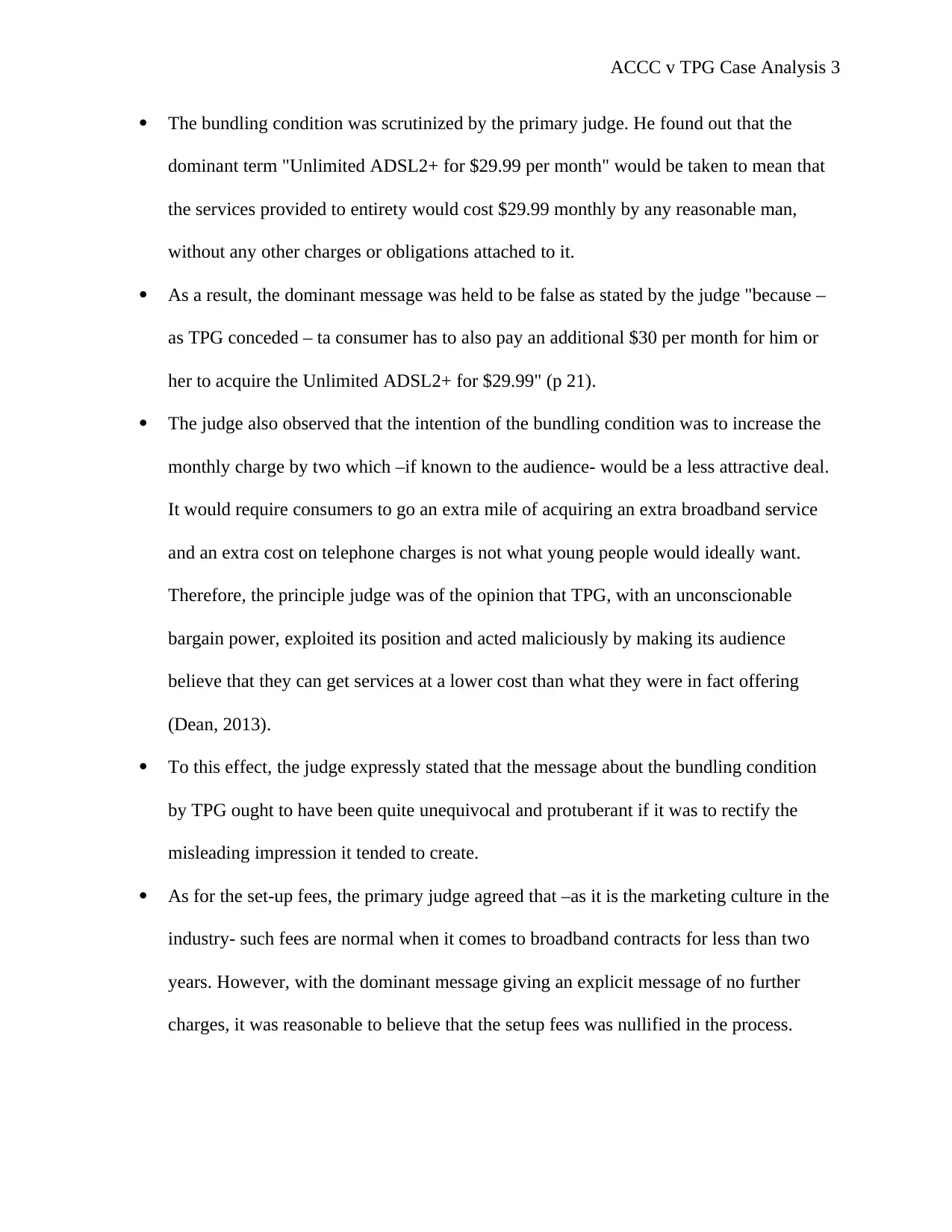
ACCC v TPG Case Analysis 3
The bundling condition was scrutinized by the primary judge. He found out that the
dominant term "Unlimited ADSL2+ for $29.99 per month" would be taken to mean that
the services provided to entirety would cost $29.99 monthly by any reasonable man,
without any other charges or obligations attached to it.
As a result, the dominant message was held to be false as stated by the judge "because –
as TPG conceded – ta consumer has to also pay an additional $30 per month for him or
her to acquire the Unlimited ADSL2+ for $29.99" (p 21).
The judge also observed that the intention of the bundling condition was to increase the
monthly charge by two which –if known to the audience- would be a less attractive deal.
It would require consumers to go an extra mile of acquiring an extra broadband service
and an extra cost on telephone charges is not what young people would ideally want.
Therefore, the principle judge was of the opinion that TPG, with an unconscionable
bargain power, exploited its position and acted maliciously by making its audience
believe that they can get services at a lower cost than what they were in fact offering
(Dean, 2013).
To this effect, the judge expressly stated that the message about the bundling condition
by TPG ought to have been quite unequivocal and protuberant if it was to rectify the
misleading impression it tended to create.
As for the set-up fees, the primary judge agreed that –as it is the marketing culture in the
industry- such fees are normal when it comes to broadband contracts for less than two
years. However, with the dominant message giving an explicit message of no further
charges, it was reasonable to believe that the setup fees was nullified in the process.
The bundling condition was scrutinized by the primary judge. He found out that the
dominant term "Unlimited ADSL2+ for $29.99 per month" would be taken to mean that
the services provided to entirety would cost $29.99 monthly by any reasonable man,
without any other charges or obligations attached to it.
As a result, the dominant message was held to be false as stated by the judge "because –
as TPG conceded – ta consumer has to also pay an additional $30 per month for him or
her to acquire the Unlimited ADSL2+ for $29.99" (p 21).
The judge also observed that the intention of the bundling condition was to increase the
monthly charge by two which –if known to the audience- would be a less attractive deal.
It would require consumers to go an extra mile of acquiring an extra broadband service
and an extra cost on telephone charges is not what young people would ideally want.
Therefore, the principle judge was of the opinion that TPG, with an unconscionable
bargain power, exploited its position and acted maliciously by making its audience
believe that they can get services at a lower cost than what they were in fact offering
(Dean, 2013).
To this effect, the judge expressly stated that the message about the bundling condition
by TPG ought to have been quite unequivocal and protuberant if it was to rectify the
misleading impression it tended to create.
As for the set-up fees, the primary judge agreed that –as it is the marketing culture in the
industry- such fees are normal when it comes to broadband contracts for less than two
years. However, with the dominant message giving an explicit message of no further
charges, it was reasonable to believe that the setup fees was nullified in the process.
⊘ This is a preview!⊘
Do you want full access?
Subscribe today to unlock all pages.

Trusted by 1+ million students worldwide
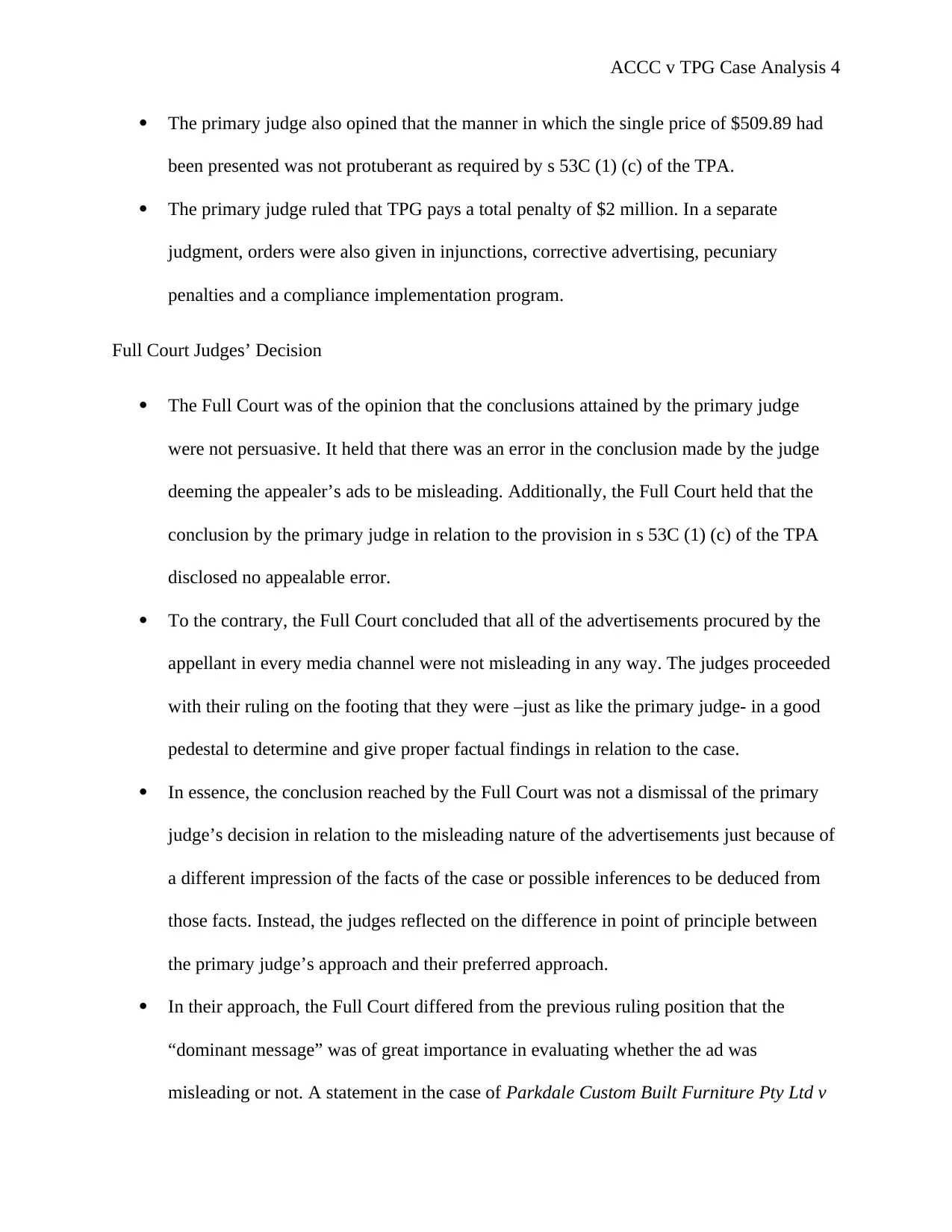
ACCC v TPG Case Analysis 4
The primary judge also opined that the manner in which the single price of $509.89 had
been presented was not protuberant as required by s 53C (1) (c) of the TPA.
The primary judge ruled that TPG pays a total penalty of $2 million. In a separate
judgment, orders were also given in injunctions, corrective advertising, pecuniary
penalties and a compliance implementation program.
Full Court Judges’ Decision
The Full Court was of the opinion that the conclusions attained by the primary judge
were not persuasive. It held that there was an error in the conclusion made by the judge
deeming the appealer’s ads to be misleading. Additionally, the Full Court held that the
conclusion by the primary judge in relation to the provision in s 53C (1) (c) of the TPA
disclosed no appealable error.
To the contrary, the Full Court concluded that all of the advertisements procured by the
appellant in every media channel were not misleading in any way. The judges proceeded
with their ruling on the footing that they were –just as like the primary judge- in a good
pedestal to determine and give proper factual findings in relation to the case.
In essence, the conclusion reached by the Full Court was not a dismissal of the primary
judge’s decision in relation to the misleading nature of the advertisements just because of
a different impression of the facts of the case or possible inferences to be deduced from
those facts. Instead, the judges reflected on the difference in point of principle between
the primary judge’s approach and their preferred approach.
In their approach, the Full Court differed from the previous ruling position that the
“dominant message” was of great importance in evaluating whether the ad was
misleading or not. A statement in the case of Parkdale Custom Built Furniture Pty Ltd v
The primary judge also opined that the manner in which the single price of $509.89 had
been presented was not protuberant as required by s 53C (1) (c) of the TPA.
The primary judge ruled that TPG pays a total penalty of $2 million. In a separate
judgment, orders were also given in injunctions, corrective advertising, pecuniary
penalties and a compliance implementation program.
Full Court Judges’ Decision
The Full Court was of the opinion that the conclusions attained by the primary judge
were not persuasive. It held that there was an error in the conclusion made by the judge
deeming the appealer’s ads to be misleading. Additionally, the Full Court held that the
conclusion by the primary judge in relation to the provision in s 53C (1) (c) of the TPA
disclosed no appealable error.
To the contrary, the Full Court concluded that all of the advertisements procured by the
appellant in every media channel were not misleading in any way. The judges proceeded
with their ruling on the footing that they were –just as like the primary judge- in a good
pedestal to determine and give proper factual findings in relation to the case.
In essence, the conclusion reached by the Full Court was not a dismissal of the primary
judge’s decision in relation to the misleading nature of the advertisements just because of
a different impression of the facts of the case or possible inferences to be deduced from
those facts. Instead, the judges reflected on the difference in point of principle between
the primary judge’s approach and their preferred approach.
In their approach, the Full Court differed from the previous ruling position that the
“dominant message” was of great importance in evaluating whether the ad was
misleading or not. A statement in the case of Parkdale Custom Built Furniture Pty Ltd v
Paraphrase This Document
Need a fresh take? Get an instant paraphrase of this document with our AI Paraphraser
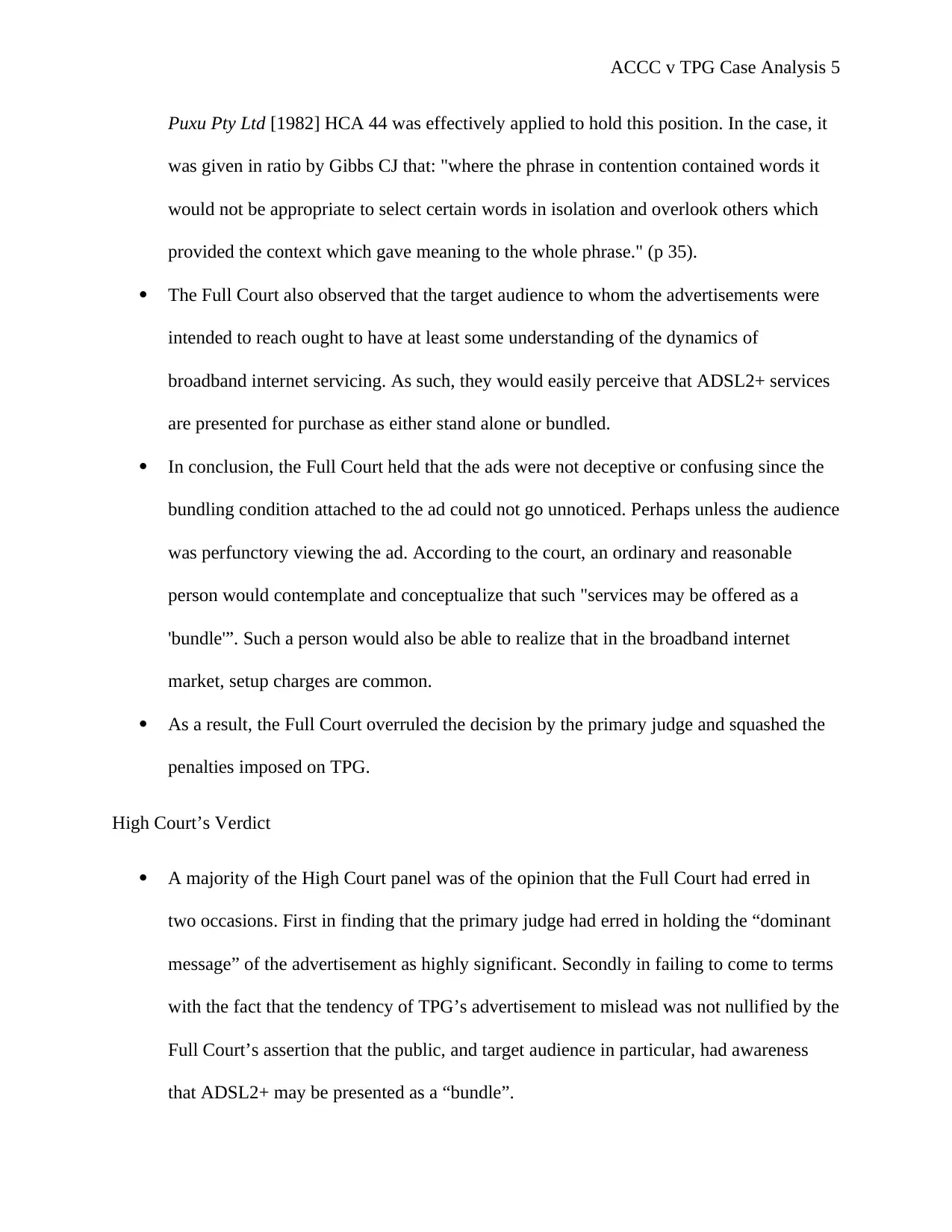
ACCC v TPG Case Analysis 5
Puxu Pty Ltd [1982] HCA 44 was effectively applied to hold this position. In the case, it
was given in ratio by Gibbs CJ that: "where the phrase in contention contained words it
would not be appropriate to select certain words in isolation and overlook others which
provided the context which gave meaning to the whole phrase." (p 35).
The Full Court also observed that the target audience to whom the advertisements were
intended to reach ought to have at least some understanding of the dynamics of
broadband internet servicing. As such, they would easily perceive that ADSL2+ services
are presented for purchase as either stand alone or bundled.
In conclusion, the Full Court held that the ads were not deceptive or confusing since the
bundling condition attached to the ad could not go unnoticed. Perhaps unless the audience
was perfunctory viewing the ad. According to the court, an ordinary and reasonable
person would contemplate and conceptualize that such "services may be offered as a
'bundle'”. Such a person would also be able to realize that in the broadband internet
market, setup charges are common.
As a result, the Full Court overruled the decision by the primary judge and squashed the
penalties imposed on TPG.
High Court’s Verdict
A majority of the High Court panel was of the opinion that the Full Court had erred in
two occasions. First in finding that the primary judge had erred in holding the “dominant
message” of the advertisement as highly significant. Secondly in failing to come to terms
with the fact that the tendency of TPG’s advertisement to mislead was not nullified by the
Full Court’s assertion that the public, and target audience in particular, had awareness
that ADSL2+ may be presented as a “bundle”.
Puxu Pty Ltd [1982] HCA 44 was effectively applied to hold this position. In the case, it
was given in ratio by Gibbs CJ that: "where the phrase in contention contained words it
would not be appropriate to select certain words in isolation and overlook others which
provided the context which gave meaning to the whole phrase." (p 35).
The Full Court also observed that the target audience to whom the advertisements were
intended to reach ought to have at least some understanding of the dynamics of
broadband internet servicing. As such, they would easily perceive that ADSL2+ services
are presented for purchase as either stand alone or bundled.
In conclusion, the Full Court held that the ads were not deceptive or confusing since the
bundling condition attached to the ad could not go unnoticed. Perhaps unless the audience
was perfunctory viewing the ad. According to the court, an ordinary and reasonable
person would contemplate and conceptualize that such "services may be offered as a
'bundle'”. Such a person would also be able to realize that in the broadband internet
market, setup charges are common.
As a result, the Full Court overruled the decision by the primary judge and squashed the
penalties imposed on TPG.
High Court’s Verdict
A majority of the High Court panel was of the opinion that the Full Court had erred in
two occasions. First in finding that the primary judge had erred in holding the “dominant
message” of the advertisement as highly significant. Secondly in failing to come to terms
with the fact that the tendency of TPG’s advertisement to mislead was not nullified by the
Full Court’s assertion that the public, and target audience in particular, had awareness
that ADSL2+ may be presented as a “bundle”.
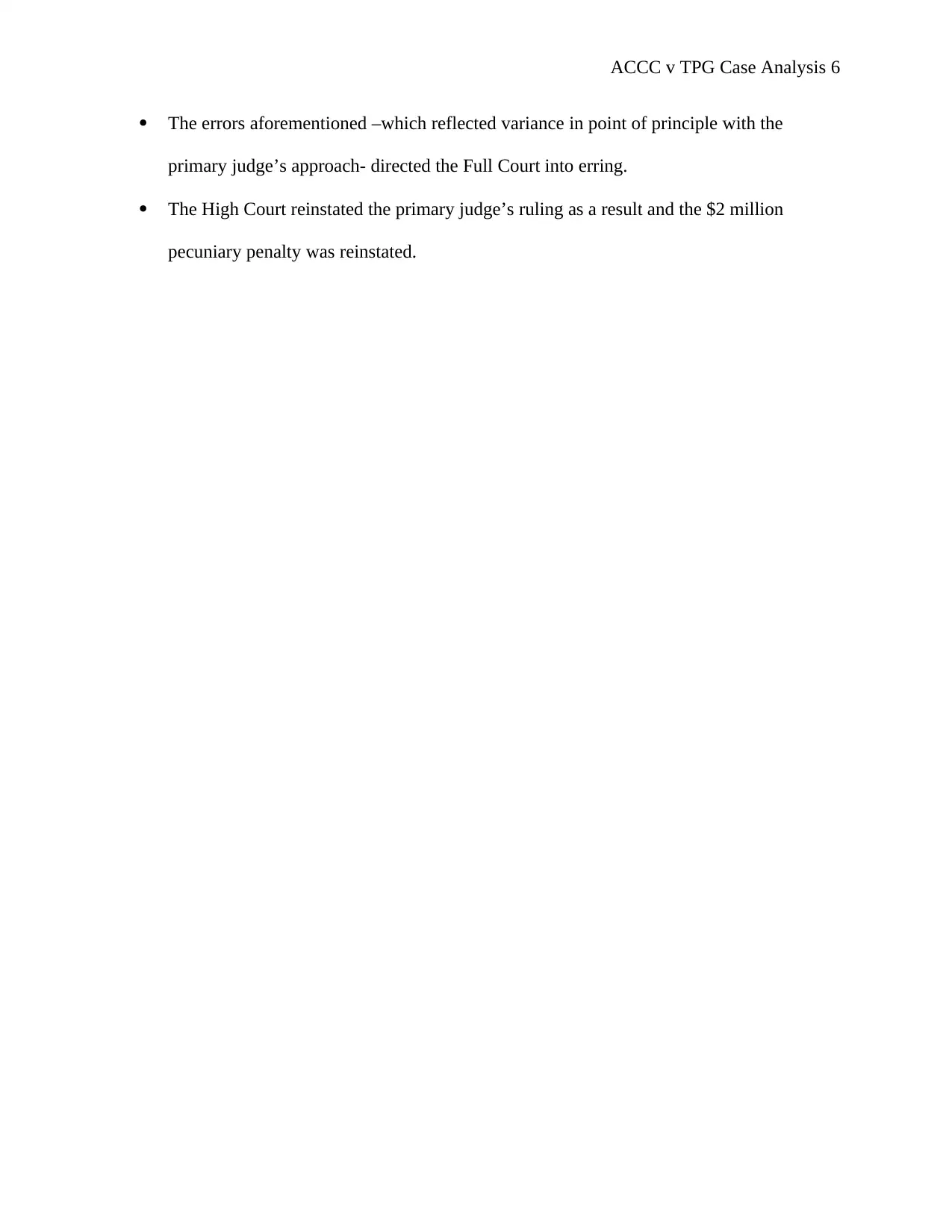
ACCC v TPG Case Analysis 6
The errors aforementioned –which reflected variance in point of principle with the
primary judge’s approach- directed the Full Court into erring.
The High Court reinstated the primary judge’s ruling as a result and the $2 million
pecuniary penalty was reinstated.
The errors aforementioned –which reflected variance in point of principle with the
primary judge’s approach- directed the Full Court into erring.
The High Court reinstated the primary judge’s ruling as a result and the $2 million
pecuniary penalty was reinstated.
⊘ This is a preview!⊘
Do you want full access?
Subscribe today to unlock all pages.

Trusted by 1+ million students worldwide
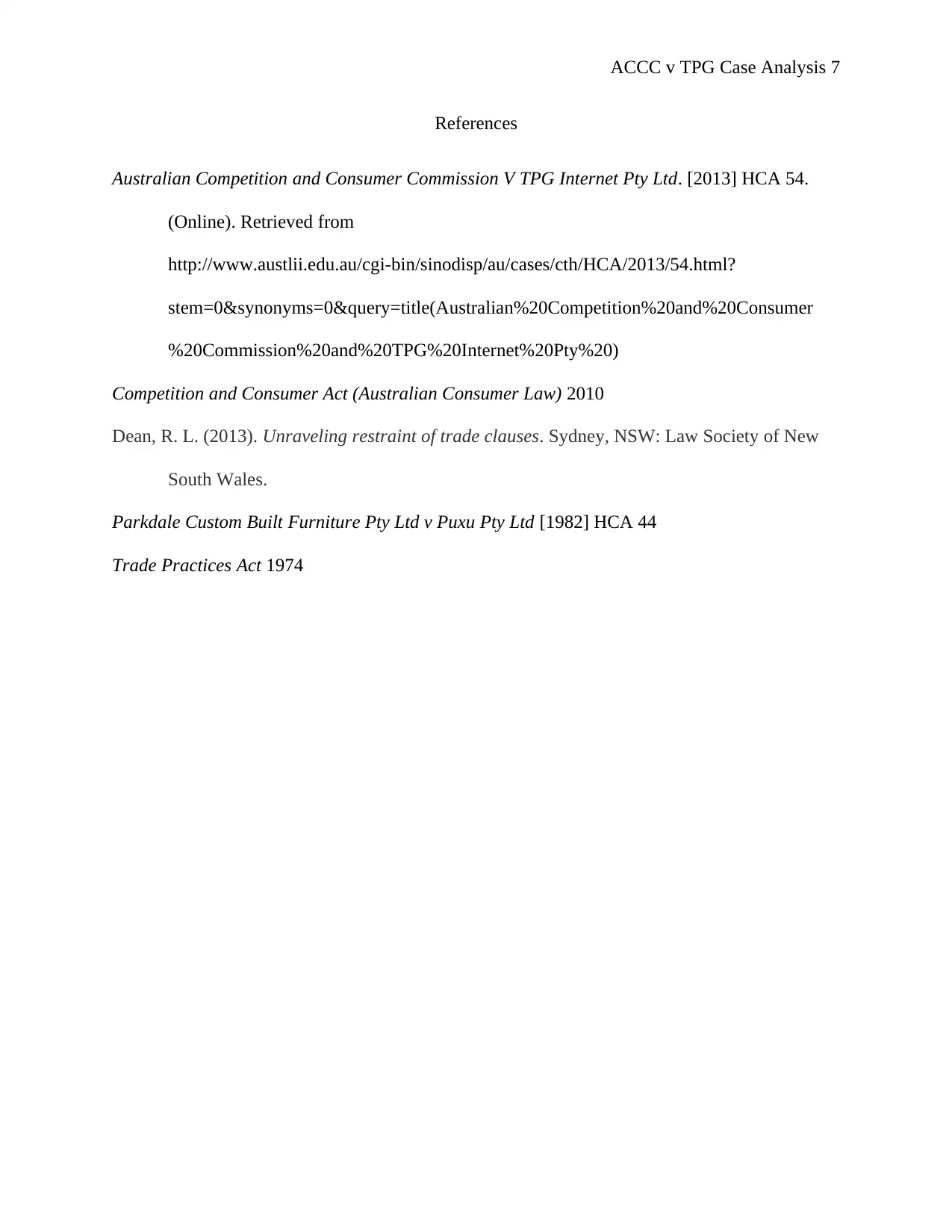
ACCC v TPG Case Analysis 7
References
Australian Competition and Consumer Commission V TPG Internet Pty Ltd. [2013] HCA 54.
(Online). Retrieved from
http://www.austlii.edu.au/cgi-bin/sinodisp/au/cases/cth/HCA/2013/54.html?
stem=0&synonyms=0&query=title(Australian%20Competition%20and%20Consumer
%20Commission%20and%20TPG%20Internet%20Pty%20)
Competition and Consumer Act (Australian Consumer Law) 2010
Dean, R. L. (2013). Unraveling restraint of trade clauses. Sydney, NSW: Law Society of New
South Wales.
Parkdale Custom Built Furniture Pty Ltd v Puxu Pty Ltd [1982] HCA 44
Trade Practices Act 1974
References
Australian Competition and Consumer Commission V TPG Internet Pty Ltd. [2013] HCA 54.
(Online). Retrieved from
http://www.austlii.edu.au/cgi-bin/sinodisp/au/cases/cth/HCA/2013/54.html?
stem=0&synonyms=0&query=title(Australian%20Competition%20and%20Consumer
%20Commission%20and%20TPG%20Internet%20Pty%20)
Competition and Consumer Act (Australian Consumer Law) 2010
Dean, R. L. (2013). Unraveling restraint of trade clauses. Sydney, NSW: Law Society of New
South Wales.
Parkdale Custom Built Furniture Pty Ltd v Puxu Pty Ltd [1982] HCA 44
Trade Practices Act 1974
1 out of 7
Related Documents
Your All-in-One AI-Powered Toolkit for Academic Success.
+13062052269
info@desklib.com
Available 24*7 on WhatsApp / Email
![[object Object]](/_next/static/media/star-bottom.7253800d.svg)
Unlock your academic potential
Copyright © 2020–2025 A2Z Services. All Rights Reserved. Developed and managed by ZUCOL.




